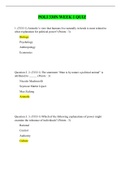Samenvatting
Extended summary and notes for History of Psychology
- Instelling
- Rijksuniversiteit Groningen (RuG)
In this document you may find extended notes on each school of psychology and its most influential authors and their contributions. For better understanding of connections and relations between, the table is coloured, thus influences among authors aro also easier to interpret.
[Meer zien]













